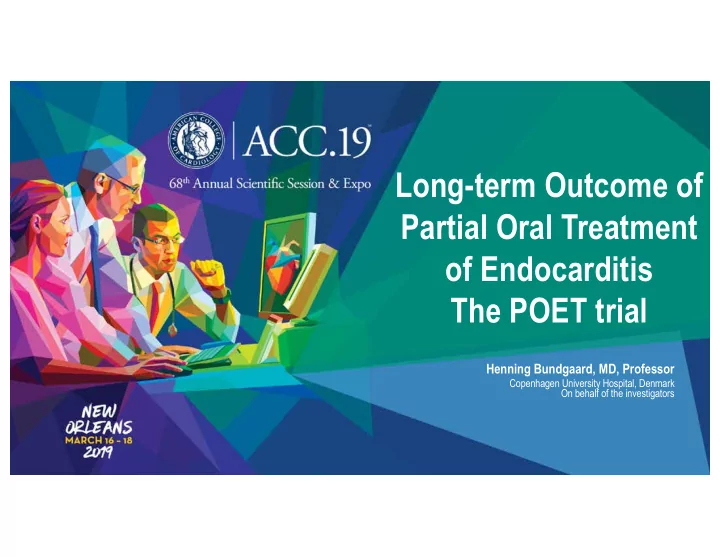

Long-term Outcome of Partial Oral Treatment of Endocarditis The POET trial Henning Bundgaard, MD, Professor Copenhagen University Hospital, Denmark On behalf of the investigators
Background • Infectious endocarditis is treated with iv antibiotics for up to 6 weeks – in-hospital • High in-hospital complication- and mortality rates - but mainly in the early phase • After stabilization the main reason for staying in hospital is to receive iv antibiotics • Hospital stays per se may cause complications
Objectives To determine in stabilised patients with endocarditis whether • A change to orally administered antibiotics - have similar efficacy and safety as • Continued intravenously administered antibiotics
Study design • Non-inferiority trial • Randomised • Nationwide including all Danish Heart centres • Cardiologists, microbiologist, infectious disease specialists, cardiothoracic surgeons
Choice of antibiotics Intravenous antibiotics: Given according to ESC guidelines Oral antibiotics regimens: Developed as part of the study; • Antibiotics with – Moderate to high bioavailability • In all cases two antibiotics; – Different drug classes, antimicrobial mechanisms and metabolization • Minimal inhibitory concentration determinations Adjustments acc. to plasma-antibiotics (pharmacokinetics T ½ , 1, 2, 4, 6 h) •
Inclusion criteria • Left-sided endocarditis based on the modified Duke criteria caused by – Streptococci or – Enterococcus faecalis or – Staphylococcus aureus or – Coagulase-negative staphylococci • ≥ 10 days of app intravenous antibiotic treatment, and ≥ 1 week after valve surgery • T <38.0 °C (<100.4 °F) >2 days • C-reactive protein dropped to ≤ 25% of peak value or <20 mg/L • White blood cell count < 15 x 10 9 /L • No sign of abscess formation by transesophageal echocardiography ≤ 48 h of randomization
The POET trial design
Primary endpoint A composite endpoint ≤ 6 months of – All cause mortality – Unplanned cardiac surgery – Embolic events confirmed by imaging – Relapse of bacteremia with the primary pathogen
Consort 1,954 patients screened for participation Major reasons for non-inclusion Not fulfilling modified Duke Criteria (n=428) Endocarditis caused by other bacteria (n=174) Too high level of CRP and/or WBC (n=132) 400 patients eligible for randomization Signs of abscess formation (n=130) Suspected reduced GI uptake (n=14) Not willing or able to consent (n=303) 199 patients assigned to 201 patients assigned to oral therapy intravenous therapy Death prior to randomization (n=71)
Baseline characteristics Oral treatment (n=201) Intravenous treatment (n=199) Age (years), mean (SD) 67.3 (12.0) 67.6 (12.6) Gender (female), n (%) 50 (25.3) 42 (20.9) Co-morbidities Diabetes, n (%) 36 (18.1) 31 (15.6) Renal failure, n (%) 25 (12.6) 21 (10.6) Dialysis, n (%) 13 (6.5) 15 (7.5) COPD, n (%) 17 (8.5) 9 (4.5) Cancer, n (%) 14 (7.1) 18 (9.1) Microbiology Streptococcus spp, n (%) 104 (52.3) 92 (45.8) Enterococcus faecalis, n (%) 46 (23.1) 51 (25.4) Staphylococcus aureus, n (%)# 40 (20.1) 47 (23.4) Coagulase-negative staphylococci, n (%) 10 (5.0) 13 (6.6)
Primary endpoint – 6 months Difference 3.1%, 95% CI: -3.4% - 9.6%, Non-inferiority met
Long-term follow-up • Primary endpoints as applied in the short-term study • Exploratory analysis • Median follow-up 3.5 years (IQR 2.3-5.1) • Blinded adjudication of prespecified clinical outcomes • Follow-up; 100%
Primary endpoint – long-term
Components of primary endpoint
Results – prespecified groups – primary outcome
Results – prespecified groups - death
Causes of death Intravenous Treatment Oral Treatment (n=199) (n=201) All cause 54 (27.1) 33 (16.4) Infection*, n (%) 14 (7.0) 10 (5.0) Cardio-vascular, n (%) 21 (10.6) 8 (4.0) Cancer, n (%) 13 (6.5) 5 (2.5) Other, n (%) 6 (1.5) 10 (4.5) * Infectious cause of death included endocarditis (two in each group).
Outpatient treatment Intravenous Oral P Time from IE diagnosis to randomisation* 17 (13-23) 17 (12-24) 0.42 Treatment after randomisation* 19 (14-25) 17 (14-25) 0.48 Length of hospital stays after randomisation* 19 (14-25) 3 (1-10) <0.001 *In days (median) (IQR)
Conclusions Efficacy and safety of changing to oral antibiotic treatment was non-inferior to continued • intravenous antibiotic treatment short term – now with reassuring longer-term outcomes in – stabilized patients with left-sided endocarditis caused by – streptococcus spp, Enterococcus faecalis, Staphylococcus aureus , or coagulase-negative staphylococci – across co-morbidities, native vs prosthetic valve and surgically vs conservatively Tx Oral antibiotics may safely be administered during approximately • – half of the recommended antibiotic treatment period – potentially as outpatient treatment More than 50% of patients with endocarditis may be candidates to partial oral antibiotic treatment •
Acknowledgements Investigators; Kasper Iversen, Nikolaj Ihlemann, Sabine U Gill, Trine Madsen, Hanne Elming, Kaare Troels Jensen, Niels Eske Bruun, Dan Eik Høfsten, Kurt Fursted, Jens Jørgen Christensen, Martin Schultz, Christine F Klein, Emil Loldrup Fosbøll, Flemming Rosenvinge, Henrik Carl Schønheyder, Lars Køber, Christian Torp-Pedersen, Jannik Helweg-Larsen, Niels Tønder, Claus Moser, Henning Bundgaard Funding; The study was supported by unrestricted grants from The Danish Heart Foundation, The Capital Regions Research Council, The Hartmann’s Foundation and Svend Aage Andersens Foundation. We thank study coordinators, safety monitoring board members, adjudication committee members and participants.
Causes of unplanned surgery Intravenous Treatment Oral Treatment (n=199) (n=201) All reasons for surgery, n (%) 18 (9.0) 12 (6.0) Endocarditis, n (%) 3 (1.5) 2 (1.0) Aortic stenosis, n (%) 7 (3.5) 3 (1.5) Aortic or mitral regurgitation, n (%) 7 (3.5) 7 (3.5) Other, n (%) 1 (0.5) 0 (0)
Safety and side-effects • Sub-therapeutic plasma levels of one oral antibiotic in 7 patients – Pharmacokinetic results did not necessitate change of antibiotic regimens in any cases • Side-effects; Intravenous 12 (6%), oral 10 (5%) – Allergy (50%), bone marrow suppression (27%) and gastro-intestinal side effects (14%) (ns)
Recommend
More recommend